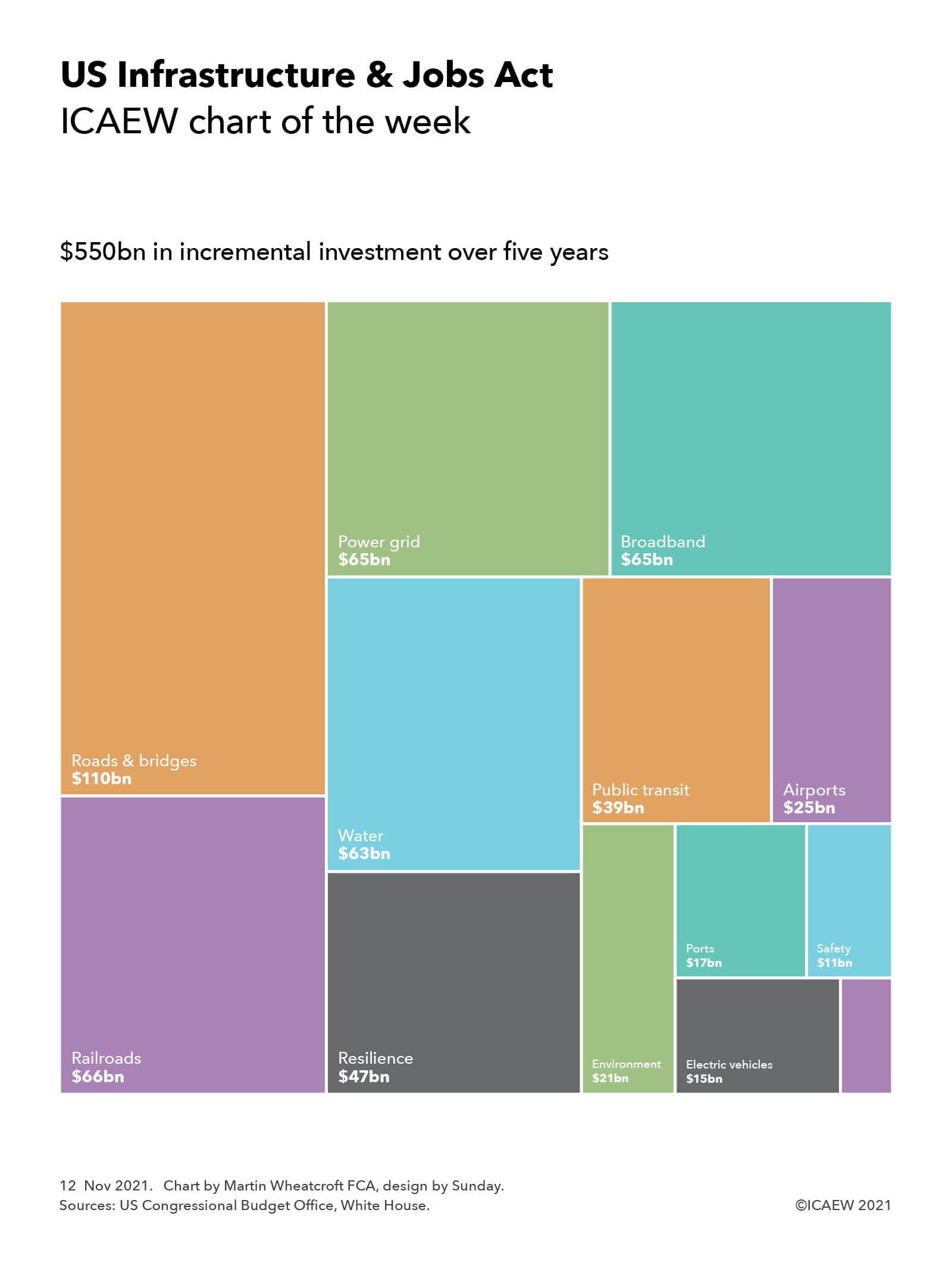
The $1.2tn US Infrastructure & Jobs Act authorises $550bn in incremental spending over five years on top of existing infrastructure investment planned by the federal government on highways, railroads, electricity networks, water, public transit, airports, and ports across the US. Passed by Congress with some bipartisan support it aims to renew the nation’s infrastructure and stimulate the economy as the US emerges from the pandemic.
The White House describes the Act as delivering “no more lead pipes, high-speed internet access, better roads and bridges, investments in public transit, upgraded airports and ports, investment in passenger rail, a network of electric vehicle chargers, an upgraded power infrastructure, resilient infrastructure, and investment in environmental remediation.”
The incremental spending can be broken down as follows:
- $110bn for roads and bridges – rebuilding the crumbling highway network, transportation research, funding for Puerto Rico’s highways, and ‘congestion relief’ in American cities
- $66bn for railroads - upgrades and maintenance of the passenger rail system, and freight rail safety
- $65bn for the power grid – investment in power lines and cables, and in clean energy
- $65bn for broadband - expanding broadband in rural areas and low-income communities, including $14bn to reduce internet bills for low-income citizens
- $63bn for water infrastructure – including $15bn for lead pipe replacement, $10bn for chemical clean-up, and $8bn for water facilities in the western half of the country to address ongoing drought conditions.
- $47bn for resilience – a Resilience Fund to protect infrastructure from cybersecurity attacks and address flooding, wildfires, coastal erosion, and droughts along with other extreme weather events
- $39bn for public transit - upgrades to public transport systems nationwide, new bus routes, and public transport accessibility for seniors and disabled Americans
- $25bn for airports - major upgrades and expansions at airports, including $5bn for air traffic control towers and systems
- $21bn for the environment – to clean up polluted ‘superfund’ and other brownfield sites, abandoned mines, and old oil and gas wells
- $17bn for ports – half to the Army Corps of Engineers for port infrastructure, with the balance to the Coast Guard, ferry terminals, and to reduce truck emissions at ports
- $15bn for electric vehicles – including $7.5bn on electric vehicle charging points, $5bn for bus fleet replacement in low-income, rural, and tribal communities, and $2.5bn for zero- and low-emission ferries
- $11bn for safety – mostly highway safety improvements, but also for pedestrian, pipeline, and other safety areas
The plan was for a combination of tax rises, economic returns on the investments made and savings from other areas (including unused pandemic-relief) to fully cover the cost of these investments, however, many of the proposed tax increases did not make it to final bill and the independent Congressional Budget Office (CBO) estimates that there is less unused pandemic-relief available than originally thought. The CBO estimates that the fiscal deficit will be $350bn higher over the next five years.
The Act is the economic infrastructure element of President Biden’s “Build Back Better Framework”, with the separate $1.75tn Build Back Better Bill covering social infrastructure (including more than a million homes for low-income families) and large amounts for social programmes. These include universal pre-school for three- and four-year olds, free community college, expanded healthcare through Medicare (for over 65s) and Medicaid (for low-income families), lower prescription drug costs, tax cuts for children and childcare support, and paid family leave. There is also some money for tax cuts for electric vehicles and other climate incentives, although more ambitious plans such as forcing utilities to phase in renewable energy are believed to be less likely to make it into the final legislation. The Build Back Better Bill does not have bipartisan support and so requires all 50 Democrats in the Senate and almost all the Democrats in the House of Representatives to agree if it is to pass.
Whether the other elements of the Build Back Better Framework come to fruition remains to be seen, but President Biden will definitely be pleased that he can chalk up this major legislative achievement.

